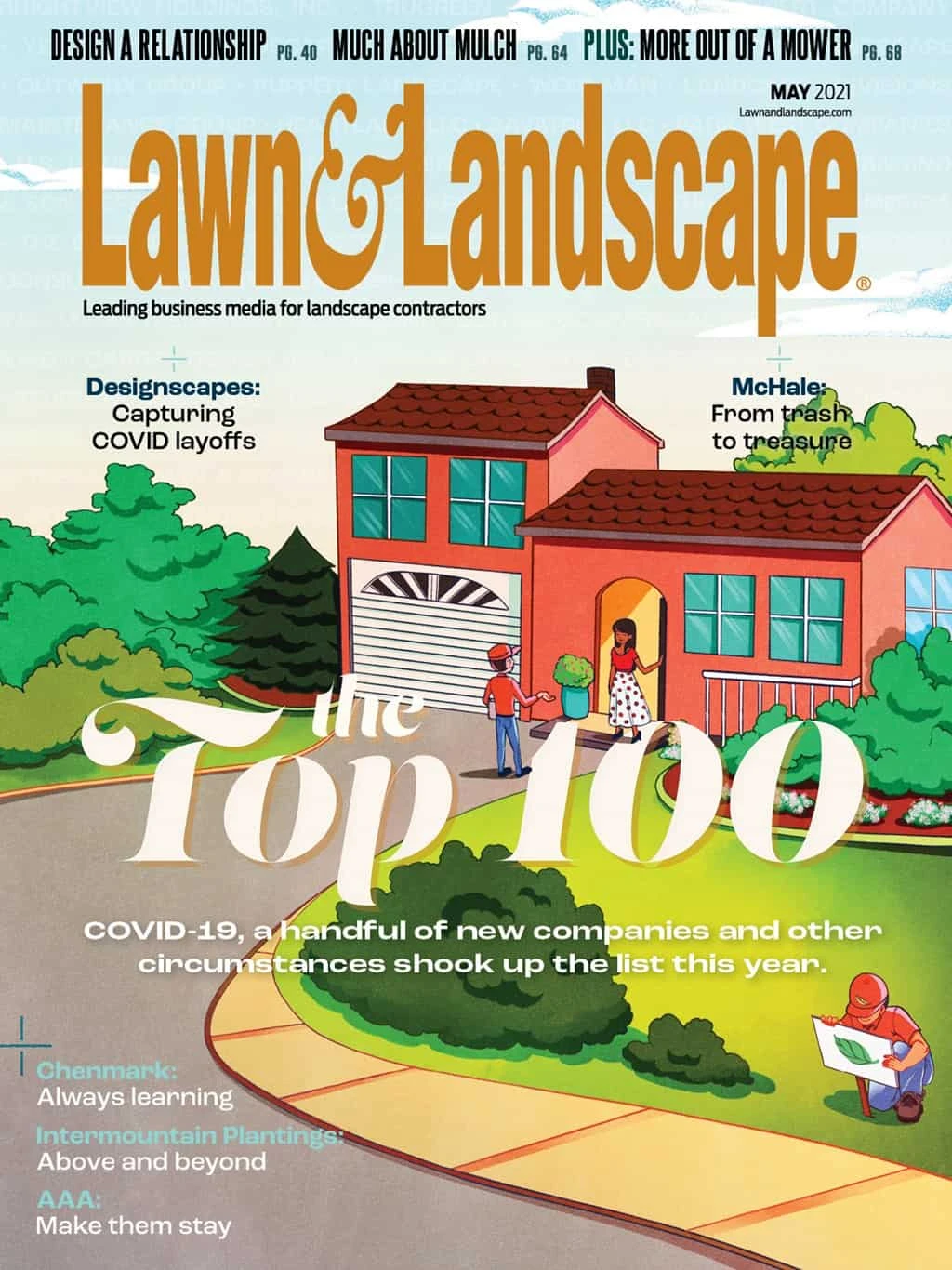

In 2006, Ian McCarthy sold his maintenance company on Cape Cod in order to invest in a professional basketball team. Fast forward to 2016: After living in Canada for six years, McCarthy found himself out of the sports industry and back on Cape Cod.
So, McCarthy went crabbing with a former friend who owned a landscaping company. That friend was looking for senior management within his company and encouraged McCarthy to get back into the industry.
McCarthy went to work for him and oversaw the company’s construction department until it was sold about a year later.
Around that same time, McCarthy, who was always close to his employees from his previous company, decided to host a homecoming of sorts to catch up with his old friends.

“I had a reunion at my house with all my former employees that were living in the area,” he says. “They were showing me pictures of stone walls and things they were building, and I thought to myself, ‘Wow. The quality is just incredible.’ And they kept urging me to start the company again.”
All of this led McCarthy to start Blue Claw Associates in 2018. He now serves as the company’s president.
“We started with two employees and started with reaching out to landscape architects and sending them flyers,” he says. “I built a website that had my old portfolio on it. I also did a job at my parents’ house to get the company going. I got a referral for a job here and there, so it was really by word of mouth at the beginning, but I was making contacts with landscape architects.”
Get in front of them.
As more and more projects came in, McCarthy continued to hire employees who worked with him in the past.
Then, Blue Claw landed its big break with a $2 million project on Nantucket Island from a well-known landscape architect.
“I hired some of the masons I used to have working for me. In fact, some of them left companies they’d been with almost 13 years to come back. I took that very seriously,” he says. “We used that project as a way to hire people, but we also were publicizing it on social media. When you’re working for one landscape architect, it gives you corporate credibility with others at their level. It started to open doors for us.”
In order to find landscape architects and designers to partner with, McCarthy says it was up to him to be proactive and seek them out.
“Initially, I designed a color mailer with lots of imagery on it. And then I wrote cover letters and actually mailed them out to them,” he says. “And then, I did a mass email. I spent painstaking time going to their websites, going to their LinkedIn pages and finding all their contact information. I even built a database for it all.”
McCarthy says keeping an eye out for new construction homes is another way to find partnerships.

“I just went looking for projects,” he says. “If you see a house under construction, you pull over and find out who the builder is. You ask the builder if there’s an opportunity to bid on it and if there’s a landscape architect involved. Then you contact the landscape architect and say, ‘I’m speaking with the builder at this project, and they said you are in charge of picking the contractor. I just wanted to introduce myself and can I send you my portfolio?’”
Social media also turned out to be a wonderful way for McCarthy to find people to partner with.
“Being able to post things on Instagram and finding landscape architects in my area and following them, inevitably they’re going to follow you back because you’re in their industry,” McCarthy says. “And then they follow your work, so in a few months when you go to reach out to them, they say, ‘Oh I know your work’ or ‘I’ve seen your projects.’ It makes that warm introduction much more feasible.”
“When you’re working for one landscape architect, it gives you corporate credibility with others at their level.” Ian McCarthy, president of Blue Claw Associates
McCarthy suggests identifying the architects and designers you want to work with and then follow everyone they follow on social platforms. He says this will get you on their radar and help you see what they’re looking for in a contractor.
“We try and attack it from all different angles,” McCarthy says of finding collaborators. “But, once we do a job with them, then we consider that we’re in a partnership with them going forward.”
Perks of the partnership.
In the past four years, Blue Claw Associates has established relationships with a core group of about a dozen landscape architects and designers.
“For us, it’s a much better model, because we’re just maintaining that relationship with the architect,” McCarthy says. “We always make them look good to their client.”
McCarthy adds the process is pretty simple.
“So, they’ll design a project for a homeowner…and once the design is done, the client asks who will install it and they say, ‘I’ve got a great company I work with called Blue Claw Associates.’ Most of the time I get a job… I’ve never met the homeowner until maybe halfway through the job.”
McCarthy says having these partnerships also allows his company to weed out more undesirable prospects who, unbeknownst to you, may just be gathering quotes from a multitude of businesses.
“If someone’s already spent between $5,000 to $50,000 on a design, they’re invested in doing the project,” he says. “Coming through this avenue, it lets you know they’re really going to do the project rather than someone who’s calling around and getting 10 prices.”
By working with various architects and designers, McCarthy says things don’t tend to get stale, either.
“It’s almost like getting a present every time a new plan comes,” he says. “You want to open it up and see if this one has an infinity pool, or really cool outdoor kitchen or fireplace. It makes it much more interesting than being a company who sells the same thing over and over again. We get to do all sorts of exciting things.”
Because Blue Claw Associates doesn’t offer design work, McCarthy says these relationships are mutually beneficial.
“It gives us the opportunity, when clients call us, we can refer them to one of our partners,” he says. “So now we’re giving them business, and that strengthens our bond. It’s a symbiotic partnership.”
And while those partnerships grow, so does the trust between the two parties.
“Along the way, if they get comfortable with our crews and our quality of work, that’s less time they have to babysit our project,” McCarthy says. “They can go out and find their next client.”
Nurture the connection.
Once relationships with architects and designers are established, fostering them is brought to the forefront of things.
“That’s the secret sauce – you can get in the door with them, but you can lose them really quickly,” McCarthy says. “In the beginning, if you don’t execute the job properly then that’ll be your last opportunity with them.”
Besides producing high-quality work, McCarthy says it all comes down to respect. For instance, if problems do arise during a job, McCarthy says it’s important to respond as a unified front with the architect as opposed to playing the blame game.
“If I find mistakes they’ve made, I usually just say, ‘Don’t worry about it’ or ‘I’ll fix it’ without exposing them,” he says. “Where, if we weren’t in that long-term relationship with them, a typical contractor might say, ‘That’s the architect’s fault – not my fault.’ But we never want to put that blame on them because we want the long-term relationship.”
“(This work is) much more interesting than being a company who sells the same thing over and over again. We get to do all sorts of exciting things.” Ian McCarthy, president of Blue Claw Associates
Knowing how to talk the talk also helps foster those relationships. “It’s really a recipe to our success to speak the language they speak and put their fears aside that we’re not going to compete with them in any way,” McCarthy says.
McCarthy says he learned how landscape architects communicate and their way of doing things by getting involved with a business developer early on.
“I worked side-by-side with him, and I watched him, and I learned how he talked,” he says. “I learned what they’re looking for, how they speak and all that. It was valuable at the time and I didn’t even realize it.”
Nowadays, McCarthy says the best thing he can do to build up his relationships with architects and designers is be readily available to them.
“It’s about being responsive, doing quality work and making sure you are proactively communicating,” he says. “One thing for me is that I always try and answer the phone. Or if I can’t, I try to call them right back or I text them. That’s something that’s missed in our industry. There are a lot of landscapers who say, ‘Oh I’m busy. I’m not answering the phone.’”
McCarthy says he has so many partnerships that it can be overwhelming at times, but there are still a few big fish he has his eye on and is hoping to work with soon.
“In any market you have companies that are looked at as higher-end, and it’s the same thing with architecture and design,” he says. “We try and take care of the ones that started with us first, but there are some that have a prestige about them that we’ve been trying to get involved with and then they finally respond, so you don’t want to turn them down.”
Focusing on these relationships has truly allowed Blue Claw Associates to grow dramatically since its inception.
“We ended up doing $2.5 million in our second year,” McCarthy says. “We had gone from two mason crews just on the Cape to having a third mason crew and now having a softscape install and landscape crew. Going into 2021, we’re up to three landscape install crews, five mason crews and a maintenance crew on the Cape. And then a landscape crew, maintenance crew and mason crew on the island. So, we’re starting off the season with 12 crews. We’re also projected in the $5 million range.”

Explore the May 2021 Issue
Check out more from this issue and find your next story to read.
Latest from Lawn & Landscape
- Our new Top 100 list goes live tomorrow
- Inside Capitol Hill: Landscape industry updates 100 days into Trump's presidency
- Bartlett Tree Experts gave away 50,000 tree seedlings for Arbor Day
- Connect, Control & Conserve with Horizon Technical Services
- Use Horizon's Parts Hotline
- How I built a Top 100 company
- Horizon’s Exclusive TurfGro Fertilizer
- Grow your business with mosquito control





